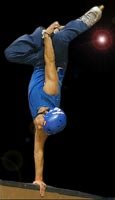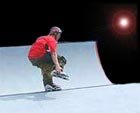I have practiced aggressive skating for five years in Montreal. I started when I was 13-years old because my friends and I were really impressed by a movie called "Airborne". After that, we went to the local skate shop to buy in-line skates. When we were in the shop, we saw a movie called "Dare to Air", one of the first specialized aggressive in-line skating movies. Done by the legendary Chris Edwards, this movie motivated us so much that we tried to do just like them.
We practiced so much that in a few weeks, we could do the tricks we had seen in the movie. But this sport evolves very fast and especially at that time because, it was new. So, we were shocked to see how the pros had evolved when we saw the next pro movie called "Mad Beef". Our goal was now to reach this level! With time, we did it but we had to face the evolution of the pros in every new movie because our dream was to become the pros.
Practice Makes Perfect!
During summers, it was easier for us to practice and reach (or almost) the pro level but during our snowy winters, it was much more difficult because we had to go to the skate park. After the fourth year, my friends and I couldn't follow the rhythm of the pros anymore because they were too good and we had to work. Some riders with whom my friends and I were riding didn't have to work because they had sponsors. My gang and I didn't have this chance because we were a little too weak in skate parks where the competitions are held. The best result that I have is 7th place in an amateur competition in Montreal. However, we were the craziest street riders of Montreal and we really lived our passion to the max. Two guys who were sponsored in Montreal and who were sometimes riding with us won the X-Games: Jonathan Bergeron and Nicki Adams.
 My friends and I have stopped or almost stopped and have put more energy in school. Do I have regrets? Not that much because I now study in Kinesiology in University and it's extremely interesting. I am learning how to prepare athletes for the competition.
My friends and I have stopped or almost stopped and have put more energy in school. Do I have regrets? Not that much because I now study in Kinesiology in University and it's extremely interesting. I am learning how to prepare athletes for the competition.
How should we train an aggressive in-line skater? First of all, we have to know that the riders have no transition phase in their training (except for people living in countries with snowing winters). They have to be at their best all year long. So, their main concern is to avoid injury and improve the quality of their tricks.
The Training
To do so, they have to do a lot of plyometric work. The stretch and shortening cycle will improve their jumping ability, which is a must in this sport if you hope to pull off burly jumps or grind handrails. Most importantly, however, it will also prevent injury. The stress done by the jumps on the bones and on the cartilage will force the osteoblasts (bone cells) to get the bones thicker and force the chondrocytes (cartilage cells) to produce more synovial liquid which nourishes the cartilages. These structures are often damaged in this sport so it's important to strengthen them. Specific plyometric drills to improve the grinding ability would be to jump with your shoes or skates on a table or a beam and land on it in the position of the grinding trick.
Another drill would be to put a rope on the floor to simulate a handrail and to jump (with your shoes or rollerblades on) on it in the grinding trick. This drill can also be done with closed eyes to improve proprioception. To improve the jumping ability, a great drill is to do trampolining. This drill will help to develop proprioception, style and stamina. Jumping in water is another great way to improve the jumping ability. This drill has the advantage to dissipate most fears and is a complement of the trampoline where the athlete can still have fears. Practicing jumping tricks by jumping from the ground and grabbing your shoes is very efficient too but, when doing this drill, it is suggested to sometimes have somebody who knows the sport to check if the style is OK.
I have made this mistake of practicing a trick by my own and when it was time to pull it on the jump, all my friends told me that my style wasn't nice at all. I had to forget everything I had done and start over with proper style.
 To improve the quality of their tricks, the majority of skaters need to improve their style. The style of a trick is how the athlete performs his trick. If it looks nice for the spectator and easy for the performer to do, then the trick is stylish. Style is influenced by the physical condition of the skater. By example, static and dynamic flexibility, stability, legs and core strength are very important.
To improve the quality of their tricks, the majority of skaters need to improve their style. The style of a trick is how the athlete performs his trick. If it looks nice for the spectator and easy for the performer to do, then the trick is stylish. Style is influenced by the physical condition of the skater. By example, static and dynamic flexibility, stability, legs and core strength are very important.
These physical qualities can be obtained by using different methods that are similar to the methods used in other sports. I hope to talk about these in future articles.
Nicolas Roy
